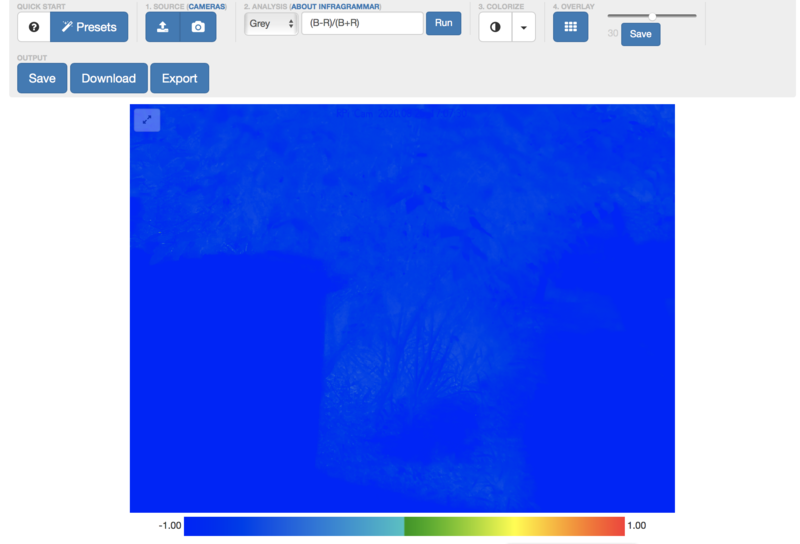Hi there
I am very new to all this and needs some help to figure out what I am doing wrong.
I am recording images on a Pi NoIR camera with a red filter (also tried a blue filter). I download the images to my laptop and then upload to infragram. I run the preset for NDVI for RED filters - colourized. But all I get is a blue image - see attached screenshot. The image is of shrubs and non-organic matter, so would expect I would be able to see a differential between things. I am really not sure what I am doing wrong?
Any advice to a newbie would be greatly appreciated.

The same image as it came out of the Pi NoIR camera without any presets/changes:

Thanks
Sam
Hi Sam
Are you sure your camera's white balance is correctly set for the red filter? I'm also new to using infragram but have obtain some interesting, though not necessarily meaningful, results by selecting the RGB option and entering about 1.5 into the "R" window.
Although reluctant to criticise such a potential valuable community research tool as infragram, I do think the application would benefit from including user instructions. This information seems currently to be scattered around general NDVI topics.
Mike.
Is this a question? Click here to post it to the Questions page.
Reply to this comment...
Log in to comment
Hi Mike
Thanks for your response. I double-checked but it looks like the white balance on the Rasberry PI NoIR is set correctly. If I turn it off, I get very red images. have set it to cloudy, and the original (non-NDVI image) looks like its fine. It's just when I run the NDVI in Infragram I get the blue images with no vegetation differentiation.
I agree I have found it difficult to find instructions. I agree too this is a fantastic resource just wish I knew better how it all worked!
Thanks Sam
Hi Sam
Did you try interning numbers into the 'red' box on instagram? Some half convincing NDVI looking effects were achieved by doing this but I would feel more confident knowing how it worked. Please let me know if you do find a comprehensive 'User Guide'.
I have been developing a low weight/power camera to take NDVI images from onboard a small 'party' foil balloon. Its based on the ESP32-CAM microcontroller board that cost less than 10$ including the camera and SD card socket.
I removed the IR blocking filter from the lens barrel and added an external red filter. There are many Arduino examples of how to program the board for automatically taking images or being triggered externally (e.g. from a PIR).
Regards, Mike.
Is this a question? Click here to post it to the Questions page.
Reply to this comment...
Log in to comment
Your photo is a little dark, and proper exposure is important to get meaningful NDVI results.
Your photo produces reasonable NDVI results with some manipulation. The NDVI image below was made in FIJI using Ned Horning's Photo Monitoring Plugin. The NIR channel was stretched while processing, something that cannot be done at Infragram. I tried your photo at Infragram and was not able to get any better results than you did.
The color scale (0-255) represents NDVI values of -1 to +1.
Chris
Is this a question? Click here to post it to the Questions page.
That's good advise regarding exposure. It took me a while to realise that the same basic rules apply to NIR, like having the sun behind the camera to minimise shadows, as visible photography.
Reply to this comment...
Log in to comment